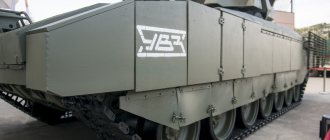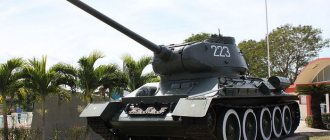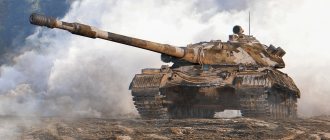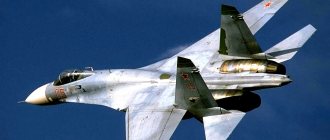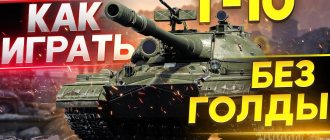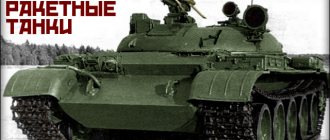After the Great Patriotic War, a rather difficult situation with heavy tanks developed in the USSR. The IS-3 turned out to be unreliable and unsuitable for service in peacetime. The IS-4 was produced in small series and was distinguished by unacceptably low workmanship. The experimental IS-6 and IS-7 were never accepted into service.
By the mid-50s, serial production of the new T-10 heavy tank was finally launched. And the designers immediately began developing new, promising machines. The most memorable of them, “object 279,” even in appearance looked more like a prop from a science fiction film.
Tank "Object 279"
At the beginning of 1956, the Main Armored Directorate of the USSR Ministry of Defense formulated the basic tactical and technical requirements for a new heavy tank, which was supposed to enter service at the turn of the 50-60s.
In particular, the weight limit was supposed to be 50-60 tons, at the same time it was planned to equip the tank with a new 130 mm gun. The terms of reference for the development of the tank were issued by the 2nd Design Bureau: Chelyabinsk Tractor Plant and Leningrad. Kirov. The selection was to take place on a competitive basis. In the 1950s, the Soviet army faced a difficult situation with heavy tanks: 4 models were in service. The IS-2 tank left over from the Great Patriotic War no longer met the requirements of the time (mainly in terms of security) and in the future was only suitable for service as bunkers. The IS-3 tank had low reliability, so it was not popular among the troops, and in terms of armor it differed only slightly from the T-54 medium tank adopted for service.
The existing IS-4 tank was a protected and powerful vehicle, but it cost 3 times more than the IS-3, while not satisfying the military’s mobility requirements and, like the IS-3, it suffered from technical problems. All three existing heavy tanks had a 122-mm D-25T rifled gun as their main armament, which by that time was already noticeably outdated.
Along with them, the T-10, which was produced in a huge series for this class of equipment, tried to take the place of the main heavy tank. This tank suited the military with its performance qualities, but could not stand comparison with its NATO counterparts - the British Conqueror and the American M103, at least until modernization to the T-10M level.
The new tank being created was supposed to replace all existing vehicles and lose the main drawback of the T-10 - weak armor protection - and effectively fight all existing and future tanks of a potential enemy. In 1957-1959, 3 prototypes were presented, but only one of them, “Object 279,” was created anew, becoming one of the most unusual and daring models in the entire history of world tank building.
Design work on the project was headed by L.S. Troyanov, who had already made his mark by creating the IS-4 heavy tank. Unlike the projects of competitors (Object 770 - ChTZ and Object 277 - another project of the Kirov plant), its heavy tank was intended for use in conditions where the enemy used nuclear weapons and in difficult terrain for vehicles.
How to penetrate object 279R in the forehead?
The only place that you can penetrate with a 250 mm shell is the tower hatches (+ 230 mm reduced), and even then only in close combat mode. Regarding the question of where to pierce 279 R in the forehead - the remaining parts can only be pierced by 340 mm cumulative and sub-caliber shells (except for the front turret).
The place of the lower frontal part is occupied by 4 tracks (on each side there are 6 built-in rollers and 3 support rollers), so there is no point in shooting down.
Vulnerable zones where 279 rubles can be penetrated are located on the upper frontal part and behind the right headlight, penetrated by a gold shell.
The area where the upper lining is rounded is also a good place to pierce 279 R on the IS 7. There is 210 mm of armor there, but at this point in the question of “where to pierce the 279 R object,” a standard armor-piercing projectile will give way to a cumulative analogue.
Four-track platform being tested.
Based on the results of tests carried out in 1959, the tank had a number of serious shortcomings in the chassis:
- loss of efficiency when driving on viscous soil,
- low agility,
- complexity of maintenance and repair,
- impossibility of reducing the overall height of the tank,
- high labor intensity of production.
Even then it became clear that the “Object 279” was not destined to become a production tank. The most highly specialized, ambitious and expensive among all three prototypes, it had to give way to them. But these plans were no longer destined to come true.
On July 22, 1960, during a demonstration of new heavy equipment at the Kapustin training ground, Yar Khrushchev categorically forbade the military to accept any tanks weighing more than 37 tons. Thus, the USSR put an end to the entire heavy tank program. However, despite this, “Object 279” remained one of the most powerful tanks in the world for many years, until the appearance of the T-80U tanks in service.
Specifications:
- Combat weight, t – 55
- Crew, people - 4;
- Dimensions;
- Case length, mm – 7280
- Length with gun forward, mm – 11,333
- Width, mm – 3400
- Height, mm – 2420
- Ground clearance, mm – 430
- Booking;
- Body forehead (top), mm/deg. – 138/60
- Body forehead (bottom), mm/deg. – 187/42
- Hull side (top), mm/deg. – 86/67
- Hull side (bottom), mm/deg. – 105/0
- Turret front, mm/deg. – 260/30
- Tower side, mm/deg. – 208/35
- Rear part of the tower, mm/deg. – 80/70
- Weapons;
- Caliber and brand of gun – 130 mm M-65
- Gun type – rifled gun
- Barrel length, calibers – 59
- Gun ammunition - 37
- Sights – TDPS, TPN-1
- Machine guns – 1 x 14.5 mm KPVT
- Power point;
- Engine type – DTN-10
- Engine power, l. With. – 1000
- Highway speed, km/h – 55
- Cruising range on the highway, km – 300
- Specific power, l. s./t – 18.2
- Specific ground pressure, kg/cm² – 0.795
- Climbability, degrees. – 35
- Fordability, m – 1.0
The mystery of "Project 279"
In 1956, Nikita Sergeevich Khrushchev instructed the designers to begin work on a project for a unique tank that was not afraid of an atomic explosion, radiation contamination of the crew, or chemical or biological attacks. The project received article number 279.
The armor is strong at 300 millimeters
And such a heavy tank weighing 60 tons was designed by 1957 at SKB-2 of the Kirov Plant of Leningrad (KZL) under the leadership of chief designer Major General Joseph Yakovlevich Kotin . It was immediately and rightly called atomic. Moreover, the lion's share of its weight was armor, in some places reaching up to 305 millimeters. That is why the internal space for the crew was much smaller than that of heavy tanks of similar weight.
The atomic tank embodied new tactics for waging World War III and a more “vegetarian” era, when human life was at least worth something. It was the concern for the crew of this armored vehicle that dictated some of the tactical and technical data of this tank. For example, if necessary, the hermetically sealed turret hatch and gun breech prevented even a speck of dust from entering the interior of the vehicle, not to mention radioactive gases and chemical agents of contamination. Bacteriological danger was also excluded for tankers.
Thus, even the sides of the hull were protected by almost twice as thick armor as the German Tigers. It reached 182 mm on the 279th. The frontal armor of the hull generally had an unprecedented thickness - from 258 to 269 mm. This exceeded the parameters of even such a cyclopean German development of the Third Reich as the heaviest monster in the history of tank building, as if jokingly called by its developer Ferdinand Porsche Maus (“Mouse”). With a vehicle weight of 189 tons, its frontal armor was 200 mm. Whereas in an atomic tank it was simply covered with impenetrable 305 mm high-alloy steel. Moreover, the body of the Soviet miracle tank was shaped like a turtle shell - shoot, don’t shoot, and the shells simply slipped off it and flew on. In addition, the giant’s body was also covered with anti-cumulative shields.
Eh, not enough shells!
that this configuration was chosen by the leading designer of the SKB-2 KZL, Lev Sergeevich Troyanov : after all, the tank was not just called nuclear - it was intended to conduct combat operations directly near a nuclear explosion. Moreover, the almost flat body prevented the vehicle from tipping over even under the influence of a monstrous shock wave. The tank's armor could withstand even a frontal hit from a 90-mm cumulative projectile, as well as a close-range shot from an armor-piercing charge from a 122-mm cannon. And not only in the forehead - the side also withstood such hits.
By the way, for such a heavyweight he had a very good speed on the highway - 55 km/h. And being invulnerable, the iron hero himself could cause a lot of trouble to the enemy: his gun had a caliber of 130 mm, and easily penetrated any armor existing at that time. True, the supply of shells gave rise to pessimistic thoughts - according to the instructions, only 24 of them were placed in the tank. In addition to the gun, the four crew members also had a heavy machine gun at their disposal.
Another feature of Project 279 was its tracks - there were four of them. In other words, an atomic tank, in principle, could not get stuck - even in complete off-road conditions, thanks also to the low specific pressure on the ground. And he successfully overcame mud, deep snow, and even anti-tank hedgehogs and gouges. During the tests in 1959, in the presence of representatives of the military-industrial complex and the Ministry of Defense, the military liked everything, especially the thickness of the armor of the nuclear tank and its complete protection from everything. But the ammunition load plunged the generals into despondency. They were not impressed by the difficulty of operating the chassis, as well as the extremely low ability to maneuver.
And the project was abandoned. The tank remained manufactured in a single copy, which is today exhibited in Kubinka - in the Armored Museum. And two other unfinished prototypes were melted down.
Flying tank
Another exotic development of our military engineers was the A-40 or, as it was also called, “KT” (“Tank Wings”). According to the alternate name, he could even... fly. The design of the “KT” (namely, we are talking about the airframe for the domestic T-60) began 75 years ago - in 1941. In order to lift the tank into the air, a glider was attached to it, which was then towed by a TB-3 heavy bomber. The person who came up with such a non-standard solution was none other than Oleg Konstantinovich Antonov , who was then working in the Glider Directorate as the chief engineer at the People's Commissariat of the Aviation Industry.
It is clear that with a weight of almost eight tons (including the glider), the tank, equipped with wings, could fly behind the bomber at a speed of only 130 km/h. However, the main thing they wanted to teach him was to land in the right place, unhooking from the BT-3 in advance. It was planned that after landing, two crew members would remove all unnecessary flight “uniform” from the T-60 and be ready for combat, having at their disposal a 20 mm caliber gun and a machine gun. The T-60 was supposed to be delivered to surrounded units of the Red Army or partisans, and they also wanted to use this method of transportation for the emergency transfer of vehicles to the necessary sections of the front.
Tests of the flying tank took place in August-September 1942. Alas, due to its low speed, the glider only just stayed at a height of forty meters above the ground due to poor streamlining and its rather solid mass. There was a war going on, and at that time such projects were not welcome. Only those developments that could become combat vehicles in the very near future were welcomed.
For this reason, the project was canceled. This happened in February 1943, when Oleg Antonov was already working in the design bureau of Alexander Sergeevich Yakovlev - his deputy. Another important point, due to which work on the A-40 was stopped, was the condition for transporting its ammunition along with the tank - this question remained open. The flying tank was also made in just one copy. But it was not the only project of our designers. There were dozens, if not hundreds, of such developments. Fortunately, our country has always had enough talented engineers.
To the English Channel!
After the end of World War II, the Soviet Union had the most powerful ground army in the world. The main striking force of the USSR in Europe was a group of troops in East Germany, numbering up to half a million soldiers and officers and several thousand tanks of the most modern models.
If the Cold War escalated into an open armed conflict, the Soviet army and its allies had to break through NATO defenses with a powerful and swift strike from armored units, enter the operational space and, after some time, reach the Atlantic Ocean.
Soviet strategists believed that nuclear weapons would be important but not decisive for success in the war. The focus was on a classic technique - seizing enemy territory.
Apocalypse tank
The development of the machine was entrusted to the design bureau of the Kirov plant. The prototype was called “Object 279” and was presented in 1959.
One of the “highlights” of the tank was its unusual appearance. The slightly flattened body was somewhat reminiscent of a flying saucer in shape. This design was supposed to prevent the machine from overturning by the shock wave from a nuclear explosion. The tank body was placed on the original chassis with four tracks, two on each side.
The engineers were able to accommodate a crew of four people in the tank. The commander, gunner and loader were located in the turret, and the mechanic sat in the front of the hull.
Design
The thickness of the armor of the cast hull reached, according to some sources, up to 269mm. The 182mm sides were even thicker than those of the IS-7. The thickness of the turret armor “all around” reached 305mm, surpassing all its predecessors. The outside of the tank was covered with anti-cumulative screens, giving the hull a characteristic elliptical shape.
Another recognizable feature of the “Object 279” was the chassis - the mover with four tracks was located almost under the hull, covering almost the entire bottom. An H-shaped 16-cylinder diesel engine was chosen as the power plant for the tank, and the transmission was hydromechanical with planetary rotation mechanisms. Fuel tanks were placed inside the beams on which the tracks were mounted.
In terms of armament, “object 279” did not differ from competitors in the competition.
The 130mm M-65 gun was equipped with an ejector and a muzzle brake, and was stabilized in two planes. When using the BR-482 armor-piercing projectile, the direct shot range exceeded 1100 m; at this distance, 240 mm thick armor was penetrated.
The projectile had a bursting charge of 115 grams of hexal. The tank used a 14.5mm KPVT as a coaxial machine gun. Its armor penetration (up to 40 mm) made it possible to destroy light equipment without using the main weapon. The stowage of shells is mechanized, with conveyors of shells and cartridges, and an electromechanical rammer. Also, “279” had night vision devices and a system of protection against weapons of mass destruction.
Terms of action
- All promotional items can be obtained in multiplayer modes and in the April Fool's event "Space Thunder" (except for the scientific data article):
- Tank arcade, realistic and simulation battles.
- Naval arcade and realistic battles.
Aviation arcade and realistic battles.
- Container - up to 40 per day and up to 400 during the entire “Space Race”.
- Containers and Scientific Data drop in battles from April 1 (16:00 Moscow time) to April 13 (15:00 Moscow time).




